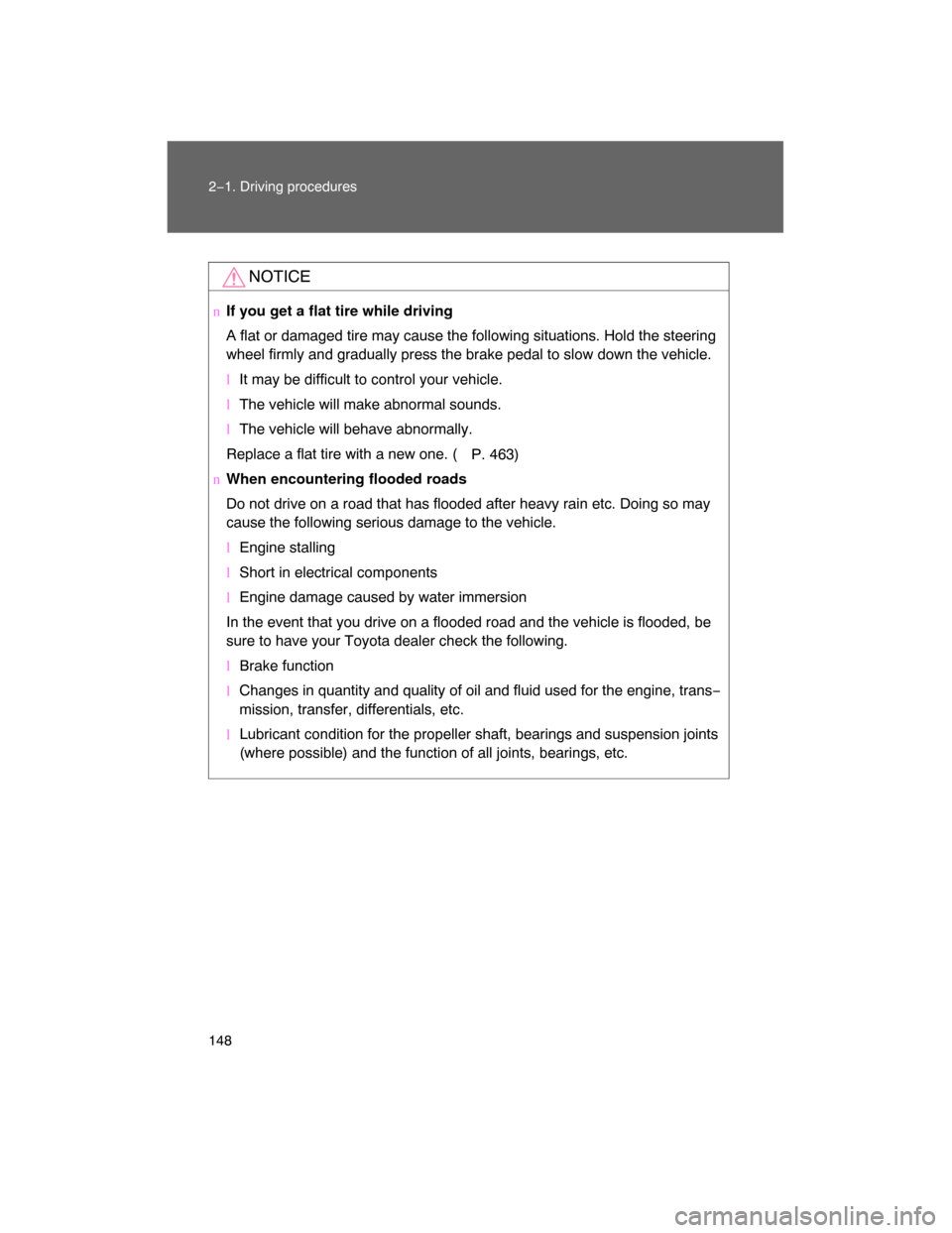Page 143 of 531

145
2−1. Driving procedures
2
When driving
CAUTION
nWhen the vehicle is parked
lDo not leave glasses, cigarette lighters, spray cans, or soft drink cans in
the vehicle when it is in the sun.
Failure to do so may result in the following:
�Gas may leak from a cigarette lighter or spray can, and may lead to a
fire.
�The temperature inside the vehicle may cause the plastic lenses and
plastic material of eye glasses to deform or crack.
�Soft drink cans may fracture, causing the contents to spray over the
interior of the vehicle, and may also cause a short circuit in the vehi−
cle’s electrical components.
lAlways apply the parking brake, shift the shift lever to “P”, stop the engine
and lock the vehicle.
Do not leave the vehicle unattended while the engine is running.
lDo not touch the exhaust pipe while the engine is running or immediately
after turning the engine off.
Doing so may cause burns.
lDo not leave the engine running in an area with snow build up, or where it
is snowing. If snowbanks build up around the vehicle while the engine is
running, exhaust gases may collect and enter the vehicle. This may lead
to death or a serious health hazard.
nExhaust gases
Exhaust gases include harmful carbon monoxide (CO) that is colorless and
odorless. Inhaling exhaust gases may lead to death or a serious health haz−
ard.
lIf the vehicle is in a poorly ventilated area, stop the engine. In a closed
area, such as a garage, exhaust gases may collect and enter the vehicle.
This may lead to death or a serious health hazard.
l
The exhaust system should be checked occasionally. If there is a hole or
crack caused by corrosion, damage to a joint or abnormal exhaust noise,
make sure to have the vehicle inspected and repaired by your Toyota
dealer. Failure to do so may allow exhaust gases to enter the vehicle,
resulting in death or a serious health hazard.
Page 144 of 531

146 2−1. Driving procedures
CAUTION
nWhen taking a nap in the vehicle
Always turn the engine off.
Otherwise, you may accidentally move the shift lever or depress the acceler−
ator pedal, which could cause an accident or fire due to abnormal engine
overheating. Additionally, if the vehicle is parked in a poorly ventilated area,
exhaust fumes may enter the vehicle and cause death or a serious health
hazard.
nWhen braking the vehicle
lIf the power brake assist function does not operate, do not follow other
vehicles closely and avoid downhill or
sharp turns that require braking. In
this case, braking is still possible, but it will require more force on the pedal
than usual. Braking distance may also increase.
lDo not pump the brake pedal if the engine stalls.
Each push on the pedal uses up the reserve for the power−assisted
brakes.
l
The brake system consists of 2 individual hydraulic systems: if one of the
systems fails, the other will still operate. In this case, the brake pedal
should be depressed more firmly than usual and braking distance
becomes longer.
Do not drive your vehicle with only a single brake system. Have your
brakes fixed immediately.
Page 145 of 531

147
2−1. Driving procedures
2
When driving
NOTICE
nWhile driving the vehicle
Do not use the accelerator pedal or depress accelerator and brake pedals
together to hold the vehicle on a hill.
nWhen parking the vehicle
Always put the shift lever in “P”. Failure to do so may cause the vehicle to
move or the vehicle may accelerate suddenly if the accelerator pedal is acci−
dentally depressed.
nAvoiding damage to vehicle parts
lDo not turn the steering wheel fully in either direction and hold it there for a
long time.
Doing so may damage the power steering pump.
lWhen driving over bumps in the road, drive as slowly as possible to avoid
damaging the wheels, underside of the vehicle, etc.
nIf you hear a squealing or scrapin g noise (brake pad wear limit indica�
tors)
Have your Toyota dealer check and replace the brake pads as soon as pos−
sible.
The rotor damage can result if the pads are not replaced when needed.
It is dangerous to drive the vehicle when the wear limits of the brake pads
and/or that of the brake discs are exceeded.
Page 146 of 531

148 2−1. Driving procedures
NOTICE
nIf you get a flat tire while driving
A flat or damaged tire may cause the following situations. Hold the steering
wheel firmly and gradually press the brake pedal to slow down the vehicle.
lIt may be difficult to control your vehicle.
lThe vehicle will make abnormal sounds.
lThe vehicle will behave abnormally.
Replace a flat tire with a new one. (
P. 463)
nWhen encountering flooded roads
Do not drive on a road that has flooded after heavy rain etc. Doing so may
cause the following serious damage to the vehicle.
lEngine stalling
lShort in electrical components
lEngine damage caused by water immersion
In the event that you drive on a flooded road and the vehicle is flooded, be
sure to have your Toyota dealer check the following.
lBrake function
lChanges in quantity and quality of oil and fluid used for the engine, trans−
mission, transfer, differentials, etc.
l
Lubricant condition for the propeller shaft, bearings and suspension joints
(where possible) and the function of all joints, bearings, etc.
Page 147 of 531
149
2−1. Driving procedures
2
When driving
Engine (ignition) switch
Modes can be switched by pr essing the “ENGINE START STOP”
switch when carrying the electronic key on your person. (The engine
can be started in any mode by operating the switch at the same time
as depressing the brake pedal.)
nChanging engine (ignition) switch mode
OFF mode
*
Emergency flashers can be
used.
ACCESSORY mode
Some electrical components
such as the audio system can
be used.
The “ENGINE START STOP”
switch indicator turns amber.
IGNITION ON mode
All electrical components can
be used.
The “ENGINE START STOP”
switch indicator turns amber.
*: If the shift lever is in a position other than “P” when turning off the
engine, the “ENGINE START STOP” switch will be turned to
ACCESSORY mode, not to OFF mode.
Page 148 of 531
150 2−1. Driving procedures
nStarting the engine
Check that the parking brake is set.
Check that the shift lever is set in “P”.
Sit in the driver ’s seat and firmly depress the brake pedal.
The “ENGINE START STOP” switch indicator turns green.
Press the “ENGINE START
STOP” switch.
Continue depressing the brake
pedal until the engine is com−
pletely started. The engine will
crank until it starts or for up to
30 seconds, whichever is less.
STEP1
STEP 2
STEP 3
STEP 4
Page 151 of 531
153
2−1. Driving procedures
2
When driving
Automatic transmission
Select a shift position appropriate for the driving conditions.
nShifting the shift lever
While the “ENGINE START STOP” switch is in IGNITION
ON mode, depress the brake pedal and move the shift
lever.
Page 155 of 531

157
2−1. Driving procedures
2
When driving
n“S” mode
When the shift range is “5” or lower, holding the shift lever toward “+” sets
the shift range to “6”.
nDownshifting restrictions warning buzzer (in the “S” mode)
To help ensure safety and driving performance, downshifting operation may
sometimes be restricted. In some circumstances, downshifting may not be
possible even when the shift lever is operated. (The warning buzzer will
sound twice.)
nWhen driving with the cruise control system
The engine brake will not operate in
the “S” mode, even when downshifting
to “5” or “4”. (P. 178)
nSecond start mode automatic deactivation
Second start mode is automatically deactivated if the engine is turned off
after driving in second start mode.
n
If the shift lever cannot be shifted from “P”
P. 478
nIf the “S” indicator does not come on even after shifting the shift lever
to “S”
This may indicate a malfunction in the automatic transmission system. Have
the vehicle inspected by your Toyota dealer immediately.
(In this situation, the vehicle will operate as if the shift lever is in “D”.)
nAI�SHIFT
The AI−SHIFT automatically shifts the gear to the optimal position according
to the driver performance and driving conditions.
The AI−SHIFT automatically operates when the shift lever is in the “D” posi−
tion. (Shifting the shift lever to the “S” position cancels the function.)